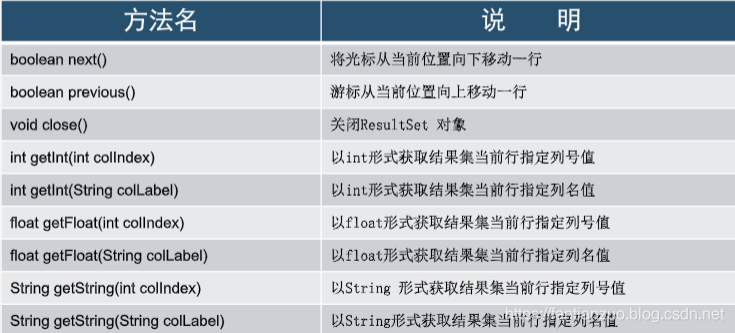- 1DOMAIN-A W ARE NEURAL LANGUAGE MODELS FOR SPEECH RECOGNITION_second-pass rescoring
- 2虚拟机 VMware 安装 WindowsXP 系统(基于 iso 光盘镜像)_winxp虚拟机镜像
- 3javax.net.ssl.SSLException 两种解决方法 链接https接口
- 4Spark ML常用函数_stringindexer setinputcols
- 5ES(Elasticsearch)的docker安装部署教程_docker 安装es
- 6人脸识别技术大总结(1)——Face Detection & Alignment_jda face detection
- 7基于ubuntu22.04系统安装nvidia A100驱动与NVLink启用_nvlink怎么开启
- 8杭电1004题c语言答案,2019年杭电多校第一场 1004题Vacation(HDU6581+数学)
- 9IDEA的Annotate或Annotate with Git Blame
- 10【辛酸总结】Github命令行上传仓库,git clone出现 fatal: unable to access解决办法_fatal: unable to access git clone
mysql——JDBC_dbijm
赞
踩
概述
JDBC:java Data Base Connectivity ,java数据库连接,它是一种用于执行sql语句的java API,为多种关系数据库提供统一访问。
其实就是一组用java编写的类和接口。
JDBC API 提供两类主要接口:
1)面向开发人员的java.sql程序包,使得Java程序员能够进行数据库连接,执行SQL查询,并得到结果集合。
2)面向底层数据库厂商的JDBC Drivers。
程序员只需要写一个程序,就可以访问所有的数据库。

提供者:sun公司
内容:
集成在java.sql和javax.sql包下,比如:
DriverManager类:管理各种驱动
Connection接口:数据库连接
Statement接口:发送命令得到结果
等等。。。
JDBC访问数据库步骤
1.加载数据库的驱动程序–
------------Class.forName(“driverName”);
2.建立数据库连接
------------Connection conn=DriverManager.getConnection(String url, String user, String password )
------------url的格式:"jdbc:<JDBC驱动程序名:端口号>:数据源"
------------例子:"jdbc:mysql://localhost:3306/myuser"
3.执行数据库操作SQL
------------Statement stmt = conn.createStatement();
------------ResultSet rs = stmt.executeQuery(sql);
4.得到ResultSet进行结果处理

•5.关闭数据库连接

PreparedStatement类
:是Statement的子接口
•用PreparedStatement类效率会更高。使用PreparedStatement有很多优势,总结如下:
–防止SQL注入攻击(使用占位符“?”)。
–提高SQL的执行性能(在执行之前有预处理)。
–避免使用SQL方言提高JDBC中有关SQL代码的可读性。


简单的写一个例子熟悉大体流程:
花卉类:
- package pojo;
- /**
- * 花卉实体类
- * @author fan
- *
- */
- public class Flower {
- private int id;//编号
- private String name;//名称
- private double price;//价格
- private String prodution;//产地
- public int getId() {
- return id;
- }
- public void setId(int id) {
- this.id = id;
- }
- public String getName() {
- return name;
- }
- public void setName(String name) {
- this.name = name;
- }
- public double getPrice() {
- return price;
- }
- public void setPrice(double price) {
- this.price = price;
- }
- public String getProdution() {
- return prodution;
- }
- public void setProdution(String prodution) {
- this.prodution = prodution;
- }
- }

对应的mysql:
- CREATE TABLE `flower` (
- `id` int(10) NOT NULL AUTO_INCREMENT COMMENT '编号',
- `name` varchar(100) NOT NULL COMMENT '名称',
- `price` double(10,2) NOT NULL COMMENT '价格',
- `production` varchar(100) NOT NULL COMMENT '产地',
- PRIMARY KEY (`id`)
- ) ENGINE=InnoDB AUTO_INCREMENT=10 DEFAULT CHARSET=utf8;
我们要JDBC完成对所有花卉的读取操作:
- package dao.impl;
-
- import java.sql.Connection;
- import java.sql.DriverManager;
- import java.sql.PreparedStatement;
- import java.sql.ResultSet;
- import java.util.ArrayList;
- import java.util.List;
-
- import com.sun.crypto.provider.RSACipher;
- import com.sun.java.util.jar.pack.Package.Class;
- import com.sun.org.apache.regexp.internal.recompile;
-
- import dao.FlowerDao;
- import pojo.Flower;
-
- public class FlowerDaoImpl implements FlowerDao{
- //查询所有花卉信息
- @Override
- public List<Flower> getFlowerInfoDao() {
- //声明jdbc变量
- Connection conn=null;
- PreparedStatement ps=null;
- ResultSet rs=null;
- //创建集合
- List<Flower> lf=null;
- try {
- //加载驱动
- Class.forName("com.mysql.jdbc.Driver");
- //创建连接对象
- conn=DriverManager.getConnection("jdbc:mysql://localhost:3306/mybatis", "root", "ytywan1314");
- //sql命令
- String sql="select * from flower";
- //创建sql命令对象
- ps=conn.prepareStatement(sql);
- //给占位符赋值
- //执行
- rs=ps.executeQuery();
- lf=new ArrayList<>();
- //遍历,封装到对象中
- while(rs.next()) {
- Flower f=new Flower();
- f.setId(rs.getInt("id"));
- f.setName(rs.getString("name"));
- f.setPrice(rs.getDouble("price"));
- f.setProdution(rs.getString("production"));
- lf.add(f);
- }
-
- } catch (Exception e) {
- e.printStackTrace();
- }finally {
- //关闭资源
- rs.close();
- ps.close();
- conn.close();
- }
- //返回
- return lf;
- }
-
- }

util
我们发现,增删改其实都差不多,我们写的时候都是把其中一个的代码拿来改一改,并且打开啊关闭啊这些操作也类似,所以我们要把操作们都得封装到一个类里,需要时直接传入sql语句还有参数调用即可。
- public class BaseDao {
- private static String driver = "com.mysql.jdbc.Driver"; //数据库驱动字符串
- private static String url ="jdbc:mysql://localhost:3306/jeep";
- private static String user ="sa"; //用户名
- private static String password =""; //密码
-
- protected Connection conn;
- protected PreparedStatement pstmt;
- protected java.sql.ResultSet rs;
- /**
- *
- * 获取数据库连接对象
- */
- public Connection getConnection(){
- Connection conn = null; //数据库连接对象
- //获取连接并捕捉异常
- try {
- Class.forName(driver);
- conn = DriverManager.getConnection(url,user,password);
- } catch (Exception e) {
- e.printStackTrace();
- }
- return conn; //返回连接对象
- }
- /**
- *
- * 关闭数据库连接
- */
- public void closeAll(Connection conn, Statement stmt, java.sql.ResultSet rs){
- //若结果集对象不为空,则关闭
- if (rs !=null){
- try {
- rs.close();
- } catch (Exception e){
- e.printStackTrace();
- }
- }
- //若Statement对象不为空,则关闭
- if (stmt !=null){
- try {
- stmt.close();
- } catch (Exception e){
- e.printStackTrace();
- }
- }
- //若数据库连接对象不为空,则关闭
- if (conn !=null){
- try {
- conn.close();
- } catch (Exception e){
- e.printStackTrace();
- }
- }
- }
- /**
- * 增删改
- */
- public int exceuteUpdate(String sql,Object...prams){
- int result = 0;
- //获取连接
- conn = this.getConnection();
- try {
- pstmt = conn.prepareStatement(sql);
- for (int i=0;i<prams.length;i++){
- pstmt.setObject(i+1, prams[i]);
- }
- result = pstmt.executeUpdate();
- } catch (SQLException e){
- e.printStackTrace();
- } finally {
- //关闭资源
- closeAll(conn,pstmt,rs);
- }
- return result;
- }
- }

properties
对于常量信息,如果每次都修改代码无疑是痛苦的事,所以我们可以提取出相应的配置文件。
比如:dbinfo.properties文件内容:
- db.driver=com.mysql.jdbc.Driver
- db.connectUrl=jdbc:mysql://127.0.0.1:3306/myqq_db?useUnicode=true&characterEncoding=UTF-8
- db.user=root
- db.pwd=
java:
- private static Properties dbProps = new Properties();
- InputStream is = DBUtil.class.getResourceAsStream("/dbinfo.properties");
- dbProps.load(is);
- Class.forName(dbProps.getProperty("db.driver"));
之后我们连接时就可以根据文件的记录来取值了。
- public static Connection getCon() {
- try {
- return DriverManager.getConnection(
- dbProps.getProperty("db.connectUrl"),
- dbProps.getProperty("db.user"),
- dbProps.getProperty("db.pwd"));
- }catch(Exception e) {
- e.printStackTrace();
- return null;
- }
- }
JDBC知识积累
1、数据连接池的工作机制?
考察点:连接池
参考回答:
J2EE 服务器启动时会建立一定数量的池连接,并一直维持不少于此数目的池连接。客户端程序需要连接时,池驱动程序会返回一个未使用的池连接并将其表记为忙。如果当前没有空闲连接,池驱动程序就新建一定数量的连接,新建连接的数量由配置参数决定。当使用的池连接调用完成后,池驱动程序将此连接表记为空闲,其他调用就可以使用这个连接。


